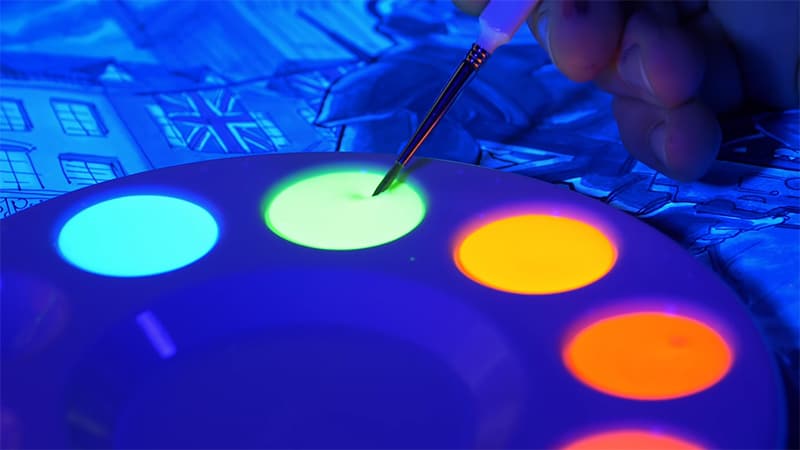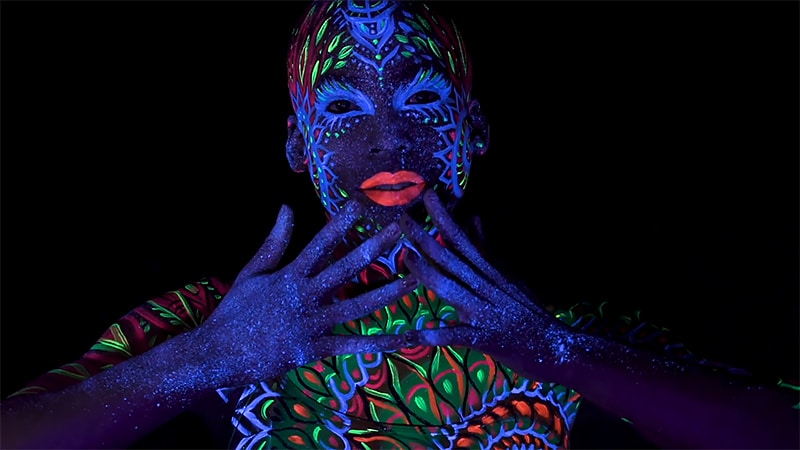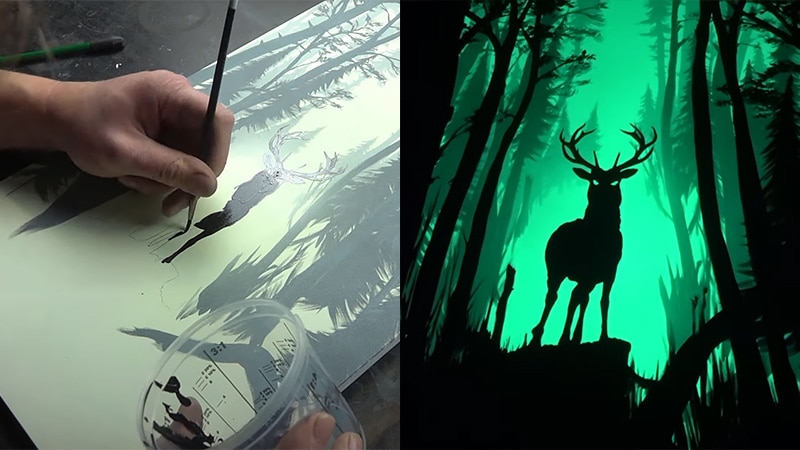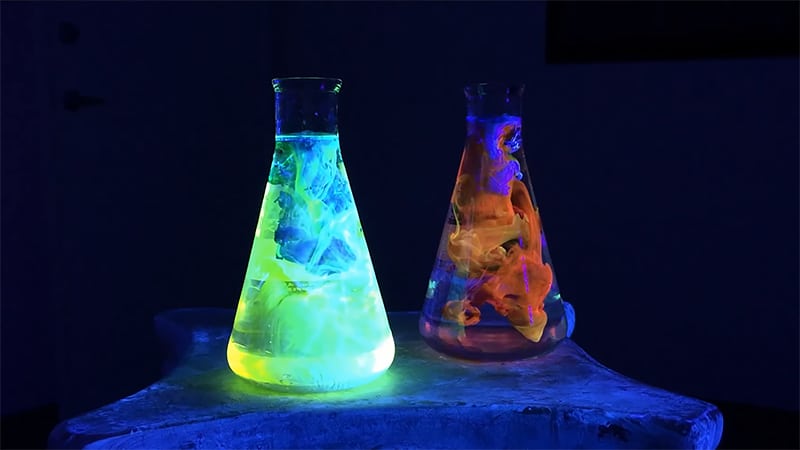
Have you ever wondered makes glow-in-the-dark paint work? Fluorescent and phosphorescent paints are used in a wide range of applications, ranging from entertainment venues to theaters. Without the proper background knowledge, you may struggle to pick the right paint or achieve your desired results. We’ve got the rundown on every type of glow paint, as well as the best possible applications for each. Glow paint has been around since the early 1990s. Since then, it has gone through many changes and been used in a wide range of applications.
Glow-in-the-Dark UV Reactive Paints
Glow-in-the-dark paints (including both the spray and liquid varieties) glow because of phosphorescence. Phosphorescence is the process in which light is emitted from a substance without heat or combustion. Phosphorescent paints absorb energy in the form of radiation. Once charged, they emit that energy in the form of faint light.
Any item that is painted in phosphorescent paint must be ‘charged’ before it can glow.
In other words, the object must be placed in direct natural or artificial light for a significant amount of time. The typically charging time for phosphorescent paint is 12 hours. Most phosphorescent paints remain visible for up to 12 hours after they have been exposed to light. They will usually fade before they stop working altogether.

Strontium Aluminate
Many next-generation manufacturers are switching over to a chemical compound called strontium aluminate. Strontium aluminate is typically combined with europium to create phosphorescent emissions. Europium is a rare-earth metal.
Manufacturers claim that Europium is cable of glowing for as long as 30 hours on a single charge.
This combination tends to produce even more vivid, long-lasting emissions than that of zinc sulfide and copper. Studies show that it is roughly 10 times as bright and lasting as the zinc sulfide alternatives.
Paints that contain strontium aluminate and europium tend to produce green and aqua-blue light. They usually dry clear so that they are completely neutral in daylight.
Zinc Sulphate
Most glow-in-the-dark paints also contain luminescent phosphors. These compounds make the paints more visible to human eyes. Green phosphors are what give most glow-in-the-dark products their signature coloration. However, zinc sulfate can also be combined with silver to create a bright blue glow.
Other popular glow-in-dark paints are made from a combination of copper and zinc sulfate. These formulas are particularly interesting because they can be used to make electroluminescent phosphor. Check out this video to see how one woman uses electricity to light up ordinary glow-in-the-dark spray paint.
If you want a quick and readily available example of luminescent phosphors, take a look at your television or computer screen when it is off. The screens on these devices contain phosphors that are illuminated when they are struck by electrons. Such screens may appear to glow even minutes or hours after they have been turned off. This is because the phosphors in the screens retain some energy.
Experimenting with Phosphorescence
Do you how we said that phosphorescent paints need to be charged? The same goes for the phosphors in televisions and computers. One way to demonstrate this phenomenon is to block some of the incoming electrons.
Alkaline Earth Metal Aluminate
While traditional glow-in-the-dark paints are blue or aqua in hue, researchers have managed to use alkaline earth metal aluminates and fluorescent pigments to create a spectrum of glow-in-the-dark pigments.
How Are Glow-in-the-Dark Paints Used?
You can use glow-in-the-dark spray paint to illuminate just about any object. Apply several coats of spray paint to get the best results. You will need to place the object in natural or artificial light to charge it. After 10 to 12 hours, it should be ready to glow. Here are video instructions on how to apply glow-in-the-dark spray paint. The glowing effect should last 4 to 8 hours. Most glow-in-the-dark paints are good for at least 1,000 charges.
Most of today’s glow-in-the-dark spray paints can be used outdoors. However, you may need to use several coats of paint as well as a clear cover coat to prevent it from becoming worn or weathered.
Why are Glow-in-the-Dark Paints Green?
You might be wondering by most glow-in-the-dark paints and materials are green. For one, the color green has a spooky connotation. This makes it perfect for Halloween decor and the likes. Moreover, neon green is easily distinguished by the human eye.
Let’s not forget the fact that zinc sulfide is inexpensive, readily available, and non-toxic.
This white, powdery mineral generates a naturally green glow whenever it is exposed to light. It is one of the most widely used active ingredients in glow-in-the-dark paints.
Phosphorescent Body Paint

Since zinc sulfide is 100% nontoxic, it is often added to body and hair products to create wearable glow-in-the-dark paints. Like most other glow-in-the-dark products, Zinc sulfide body and face paints need to be charged before use. They usually last 4 to 8 hours. They sometimes leave behind a faint glow.
Fluorescent Paint
Most fluorescent paints do not contain any photoluminescent ingredients. As such, they cannot be considered ‘glow-in-the-dark.’ Still, most fluorescent paints appear to glow when they are exposed to long-wave ultraviolet (UV) radiation. Why is this?
The pigments in fluorescent paints are particularly reactive to light on the UV spectrum.
Unlike phosphorescent paint, fluorescent paint needs constant exposure to natural or artificial light to work. In other words, a fluorescent paint’s glow can only be sustained as long it is exposed to UV light.
A talented artist can use fluorescent paint to create stunning effects. Check out this video to see how fluorescent paint can be used to transform ordinary images into multi-dimensional displays.
Black Light Paint
Black light paint is just another name for fluorescent paint, which, as you now know, is specifically designed to work under Uv light. These paints contain pigments that respond well to ultraviolet lights. White and fluorescent pigments respond best to light on the UV spectrum. As such, most black light paints are available in green, yellow, orange, and pink.
Boosting the Glow
Some black light paints contain luminescent phosphors. These compounds help strengthen the paints’ radiance in dark conditions. Here’s a complete list of luminescent phosphors, should you want to check a fluorescent paint’s ingredient list.
Applying Black Light Paints

UV-reactive paints can be applied just like regular acrylic paints. Most experts recommend that you apply a white primer before you brush on your final design. It’s also a good idea to apply multiple coats. This is because most acrylic paints are semi-transparent. UV light has an easier job of bouncing off of paints when the colors are opaque.
Creating Hidden Messages and Multidimensionsal Art
UV paint can be applied directly over regular images. This technique is often employed to reveal secret messages and symbols or transform entire sections of an image into something new. The difference between a UV paint-embellished image under UV and regular lighting is as dramatic as day and night.
Shading with Black Light Paints
Many artists use a mix of black light and traditional acrylic paints to create images that appear to be on a grayscale under regular light but are colorful under UV lighting. Here’s one guide to shows you how to create transition grays with UV-reactive paints.

Strengthen the Visibility of Black Light Paint in Daylight
You can add fluorescent paint to similarly colored acrylic paint to give it a stronger appearance in daylight. We strongly recommend that you mix and apply such paints under UV lighting. This way, you can be sure that the traditional pigments do not have an undesirable appearance once the backlights are turned on.
An alternative and equally popular method requires the application of fluorescent paint or even phosphorescent paint over acrylic paint.
Why Do Only Some Pigments Glow in UV Lighting?
Fluorescent colors are capable of absorbing more light than other colors. Moreover, they are capable of responding to light that isn’t on the typically visual scale (e.i. ultraviolet light). We come across fluorescent colors every day. People often refer to fluorescent colors and neons. Fluorescent colors appear much brighter than conventional colors.
Other Types of Paints That Glow
Radioluminescent, or luminous, paint gives off light. These paints contain small amounts of radioactive isotopes and radioluminescent phosphors. Unlike photoluminescent paints, they do not need to be charged.
They will continue to glow until the phosphor degrades, which is usually several years after their application.
While radioluminescent paints are highly effective, they are rarely ever used in consumer products. This is because they contain radium, a metal that has been deemed radioactive and, therefore, unsafe for use. For a while, it seemed as though radioluminescent paints were going to be completely eradicated.
Once radium was deemed unsafe, most manufacturers switched over to promethium. While this metal is safer than radium, it does not last long. Thus, manufacturers have turned to tritium. This type of radioluminescent paint is used to illuminate watches, aircraft dials, compasses, sights, and more.
What Type of Glow Paint Should You Be Using?

Now that you have a solid understanding of the different types of glow paints, you’re probably wondering which one you should be using and why.
Phosphorescent paint can be used to enhance all sorts of projects. It is readily available in spray and liquid forms. We recommend this sort of paint for anyone looking to add glow-in-the-dark details to an object. Most phosphorescent paints do not contain pigments. As such, they appear neutral in daylight. Since phosphorescent materials require nothing more than natural or artificial light for activation, they can be used in just about any setting.
UV-reactive paints are a bit more cumbersome. After all, they require the presence of UV light for activation. With that said, these paints come in a variety of hues. Not to mention the fact that fluorescent paints can be mixed with conventional paints. As such, they are our preferred selection for purely artistic ventures, including indoor murals, paints, and room decor.
Glowing Colors
Keep in mind that pigments have different energy levels. Therefore, some fluorescent colors appear brighter, more vivid than others.
Researchers have already concluded that yellow-green is the most vivid fluorescent color.
As such, this color is often used for high-visibility safety apparel and gear. This is followed closely by aqua. Check out The Realm of Color for a complete list of neon colors.
Wrapping Up
We had so much fun discussing glow-in-the-dark colors! Drop any of your remaining questions or comments in the section below, and we’ll be sure to get back to you ASAP!


